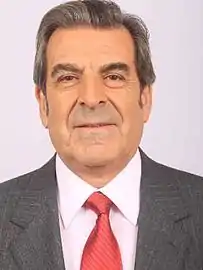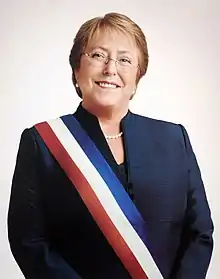President of Chile
The president of Chile (Spanish: Presidente de Chile), officially known as the president of the Republic of Chile (Spanish: Presidente de la República de Chile) is the head of state and head of government of Chile. The president is responsible for both the Chilean government and state administration.[2] Although its role and significance has changed over the history of Chile, as well as its position and relations with other actors in the national political organization, it is one of the most prominent political figures. It is also considered as one of the institutions that make up the "Historic Constitution of Chile", and is essential to the country's political stability.[3]
| President of the Republic of Chile Presidente de la República de Chile | |
|---|---|
 | |
| Style | His Excellency |
| Residence | No official residence |
| Seat | La Moneda Palace |
| Appointer | Direct popular election |
| Term length | Four years, not eligible for re-election immediately |
| Inaugural holder | Manuel Blanco Encalada |
| Formation | 9 June 1826 |
| Succession | Minister of the Interior (as ex officio "Vice-President") |
| Salary | 190,466 USD annually[1] |
| Website | www |
.svg.png.webp) |
|---|
| This article is part of a series on the politics and government of Chile |
| Comptroller General |
| Constitutional Court |
|
|
Under the current Constitution (adopted in 1980), the president serves a four-year term, with immediate re-election being prohibited. The shorter period (previously the term was six years) allows for parliamentary and presidential elections to be synchronized. The official seat of the president of Chile is the La Moneda Palace in the capital Santiago.
Since 2018, Sebastian Piñera is the current president. He won the 2017 Chilean general election and assumed the office on 11 March 2018 for the second term. Previously, he held the position for the first term from 11 March 2010 - 2014.
Features of the office
Requirements
The Constitution of 1980 and its 2005 amendment establishes the requirements for becoming president. The president must be a natural-born citizen of the country, or else born overseas when one of his or her parents or grandparents is a Chilean national. The president must also be at least 35 years old.[4] In addition, all the requirements for becoming a Senator apply. The president must meet all the requirements to qualify as a fully Chilean citizen with the right to vote: they must have reached the age of eighteen years and have never been sentenced to severe punishment, nor lost the right to vote on grounds of insanity, been tried for a crime attracting severe punishment or for terrorist conduct, or condemned by the Constitutional Court under Article 8 of the Constitution.
Election
Article 26 detail the electoral requirements. The president shall be elected by direct ballot, with an absolute majority of the votes validly cast. A two-round system is used. In order to win the election in the first round, the winning candidate's party must receive more than 50 percent of the valid votes leaving out of the count blank and spoiled votes.
The election shall be held the third Sunday of November of the year immediately before the end of the administration of the president then holding office. Should there be more than two candidates in the presidential election, none of them obtaining more than half of the votes validly cast, a new election shall be held. The second election ("balloting"), in the manner determined by law, shall be held the fourth Sunday after the first election, limited to the two candidates with the highest relative majorities. Then, the candidate with the majority of valid votes in that round is elected president.
Term duration
Under the 1828 constitution, the president served for four years, without the possibility of immediate reelection for one more term. In 1833, the presidential period was changed to five years, with a possibility of immediate reelection for one more term, limited to two consecutive terms. Then by a constitutional reform in 1878, possibility for reelection became disallowed. Under the 1925 constitution, the president served for a six-year term, without the possibility of immediate reelection only.
In the original text of the 1980 constitution, the president served for an eight-year term without the possibility of immediate reelection. Some transitory disposals, fixed during the government of the general Augusto Pinochet, allowed the exceptional possibility of his reelection in the 1988 plebiscite. Then, in the transition to democracy the 1989 referendum established a first transitional four-year presidential term (1990–1994), followed by common eight-year terms, without the possibility of immediate reelection. However, in 4 March 1994 (a week before Eduardo Frei Ruiz-Tagle took office) the presidential period was reduced to a six-year term, without an immediate reelection.
Under the 2005 constitutional reform, the president serves for four years without the possibility of immediate reelection for one more term. A former president may run for office once again after serving their initial term, but only in an election following their successor, as it is not allowed to run for consecutive terms. There is no limit to how many times a person can run for candidacy if they have not previously served as president.
The incumbent president, in accordance with the constitution, completes their corresponding term on 11 March of the immediate year after the election. The president-elect takes office the same day.
Presidential sash



The presidential sash, used initially by Bernardo O'Higgins, became a symbol of the authority of the first president with the assumption of office by President José Joaquín Prieto in 1831. It is composed of three stripes with the colors of the Chilean flag, it is sewn by hand and measured approximately 75 cm long and 13 cm wide.
From the nineteenth century a single sash was maintained that was transferred from president to president until 1915, due to the height differences between the outgoing Ramón Barros Luco and the elected Juan Luis Sanfuentes, so a new sash had to be designed. Since that date, each president has had his or her own presidential sash, which is used only in official ceremonies.
O'Higgins Pioche
The O'Higgins Pioche, which is considered the symbol of presidential power and is placed at the lower end of the presidential sash, is a star of five ends of about 7 cm in diameter, enameled in red. It dates back to the medals of the Legion of Merit and remained intact until the coup d'etat of 1973, when it disappeared during the bombing of the La Moneda palace. During the military regime of Augusto Pinochet a replica of the pioche was created, based on photographs of the original. It is only used together with the presidential sash.

Ford Galaxie 500
The ceremonial presidential vehicle in Chile is a 1966 black Ford Galaxie XL Convertible, given as a gift by Her Majesty Queen Elizabeth II on her visit to Chile. It is used only for official ceremonies celebrating national days on 21 May, 18 and 19 September, and presidential inaugurations which take place on 11 March every four years. It has a normal license plate (EL-2801).[5]
Succession
In the case when the president is unable to perform his/her duties, his/her powers are usually temporarily transferred to the Minister of the Interior under the title of "vice president"; however this is not a true vice presidential position, but rather a position of a designated acting president. If the president and minister of the Interior are both temporarily unavailable, the next minister of the government, in the order of succession, becomes the "vice president".
Living former presidents
There are three living former Chilean presidents:

Eduardo Frei Ruiz-Tagle
(served 1994–2000)
24 June 1942.png.webp)
Ricardo Lagos
(served 2000–2006)
2 March 1938
Michelle Bachelet
(served 2006–2010; 2014–2018)
29 September 1951

.jpg.webp)
.jpg.webp)
Ruiz-Tagle, Lagos and Bachelet are the remains of the living formers, when Piñera assumed again as president on 2018. The most recent former president to die was Patricio Aylwin, aged 98, on 19 April 2016.
References
- "IG.com Pay Check". IG.
- See Sentencia Rol 78-1989 of the Constitutional Court of Chile, relapsed on the Central Bank of Chile's Constitutional Act project (declarations Nº 7 to 13).
- Bravo Lira, Bernardino (1996). "Introducción. Raíz y razón del Estado de derecho en Chile". El Estado de Derecho en la Historia de Chile. Santiago, Chile: Ediciones Universidad Católica de Chile.
- "Archived copy". Archived from the original on 24 July 2016. Retrieved 17 July 2016.CS1 maint: archived copy as title (link)
- "::: I. Municipalidad De Talagante :::". Munitalagante.cl. Archived from the original on 26 March 2009. Retrieved 25 April 2009.
External links
- Presidencia (in Spanish)
